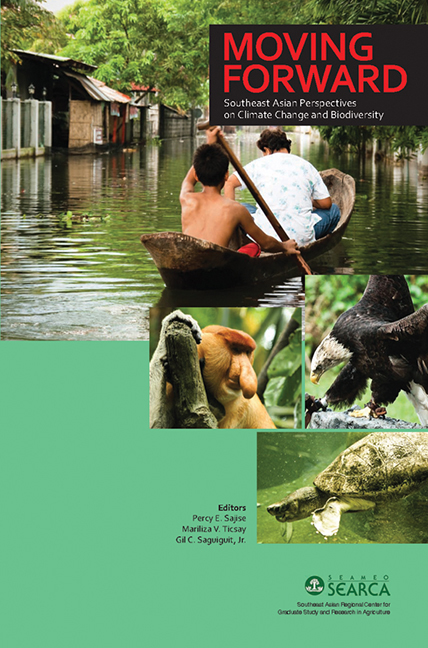Book contents
- Frontmatter
- Contents
- Tables
- Figures
- Foreword
- Preface
- Contributors
- Acronyms
- INTRODUCTION
- REGIONAL PERSPECTIVES AND CROSS-CUTTING ISSUES
- 2 Issues on Climate Change and Biodiversity in the Region
- 3 Climate Change in the Montane Mainland Southeast Asia: Reflections on Water Resources and Livelihoods
- 4 Climate Change, Biodiversity, Livelihoods, and Sustainagility in Southeast Asia
- COUNTRY PERSPECTIVES
- CHALLENGES AND FUTURE ACTIONS
- Index
2 - Issues on Climate Change and Biodiversity in the Region
from REGIONAL PERSPECTIVES AND CROSS-CUTTING ISSUES
Published online by Cambridge University Press: 21 October 2015
- Frontmatter
- Contents
- Tables
- Figures
- Foreword
- Preface
- Contributors
- Acronyms
- INTRODUCTION
- REGIONAL PERSPECTIVES AND CROSS-CUTTING ISSUES
- 2 Issues on Climate Change and Biodiversity in the Region
- 3 Climate Change in the Montane Mainland Southeast Asia: Reflections on Water Resources and Livelihoods
- 4 Climate Change, Biodiversity, Livelihoods, and Sustainagility in Southeast Asia
- COUNTRY PERSPECTIVES
- CHALLENGES AND FUTURE ACTIONS
- Index
Summary
Climate change is fast becoming a present reality. The most recent IPCC (2007) report concludes that:
“…warming of the climate system is unequivocal, as is now evident from observations of increases in global average air and ocean temperatures, widespread melting of snow and ice, and [the] rising global average sea level… (Denman et al. 2007).”
Among the projected impacts of climate change is the loss of thousands of species, as well as changes in natural ecosystems. Indeed, climate change is a real threat to biodiversity. Globally, about 20-30 per cent of species will be at increasingly high risk of extinction, possibly by 2100, as global mean temperatures exceed 2-3°C above pre-industrial levels. Global uncertainty range from 10 to 40 per cent, but varies among regional biota from as low as 1 per cent to as high as 80 per cent (Fischlin et al. 2007).
The Millennium Ecosystems Assessment (2005) concluded that in the past 50 years, humans have changed ecosystems more rapidly and extensively than in any comparable period of time in history. These changes have been made mainly to meet the rapidly growing demands for food, fresh water, timber, fiber, and fuel. These changes have resulted in a substantial and largely irreversible loss in the diversity of life on earth. It is expected that climate change will exacerbate existing pressures on biodiversity resources.
The Southeast Asian region is among the few countries with the richest biodiversity resources in the world. Although occupying only 3 per cent of the world's total surface, 20 per cent of all known species live deep in its mountains, jungles, rivers, lakes, and seas. The tropical forests harbor 10 per cent of the world's floral diversity (Gitay et al. 2002). Three of the world's 17 mega diversity countries are in the region, particularly in Indonesia, Malaysia, and the Philippines.
Southeast Asia also has seven of the world's 25 recognised biodiversity hotspots or areas that are known to be biologically rich but are under the greatest threat of destruction. There are more than 27,000 endemic species in the region.
- Type
- Chapter
- Information
- Moving ForwardSoutheast Asian Perspectives on Climate Change and Biodiversity, pp. 11 - 30Publisher: ISEAS–Yusof Ishak InstitutePrint publication year: 2010



